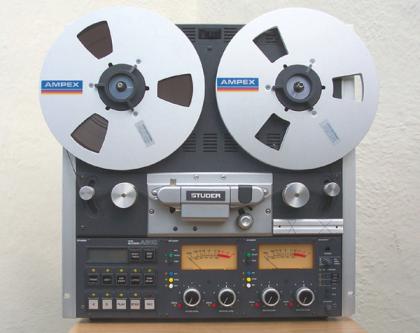Tapes come in many sizes, track formats and speeds 1.78 - 3.75 - 7.5 - 15 & 30 ips. The cost of transfer usually depends on three considerations: 1) The length of tape 2) The recording speed 3) The number of recorded tracks. All these factors determine the final price. Therefore, most open reel tapes need to be checked in the studio before a quotation can be given. ------------------------------ All hiss and noise levels are digitally cleaned up as part of the transfer procedure. All tapes are played on professional machines, either Studer A807-A810-Revox B77 or Preco F500 BBC recorders. Reel to reel mix-down facillities available for 8, 16 & 24 track formats - price on application. Should your tapes suffer from "sticky shed syndrome" we can offer a baking service.
History Reel-to-reel, open reel tape recording is the form of audio recording in which the recording medium is held on a reel, rather than being securely contained within a cassette. In use, the supply reel or feed reel containing the tape is mounted on a spindle; the end of the tape is manually pulled out of the reel, threaded through mechanical guides and a tape head assembly, and attached by friction to the hub of a second, initially empty takeup reel. The arrangement is similar to that used for motion picture film. The reel-to-reel format was used in the very earliest tape recorders, including the pioneering German Magnetophon machines of the 1930s. Originally, this format had no name, since all forms of magnetic tape recorders used it. The name arose only with the need to distinguish it from the several kinds of tape cartridges or cassettes which were introduced in the early 1960s. Reel-to-reel tape was also used in early tape drives for data storage on mainframe computers, video tape recorder (VTR) machines, and later for high quality analog audio recorders as early as the late 1940s, up until modern day studios where it is still in use. Studer, Stellavox, Nagra, Denon and Otari, Inc. currently manufacture analog reel-to-reel recorders. Following the example set by Bing Crosby, high-speed reel-to-reel tape recorders rapidly became the main recording format used by audiophiles and professional recording studios until the late 1980s when digital audio recording techniques began to allow the use of other types of media (such as Digital Audio Tape (DAT) cassettes and hard disks).
Transfer - Copy - Convert LP to CD | Vinyl to CD | 78 to CD | Tape to CD | Cassette to CD | DAT to CD | |||||||||||||||||||||||||||||||||||||||||||||||||||||||||||||||||||||||||||||||||||||||||||||||||||||||
|
|
|
|





































